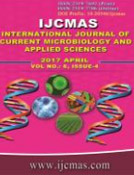


 National Academy of Agricultural Sciences (NAAS)
National Academy of Agricultural Sciences (NAAS)

|
PRINT ISSN : 2319-7692
Online ISSN : 2319-7706 Issues : 12 per year Publisher : Excellent Publishers Email : editorijcmas@gmail.com / submit@ijcmas.com Editor-in-chief: Dr.M.Prakash Index Copernicus ICV 2018: 95.39 NAAS RATING 2020: 5.38 |
In India, among different cultivars of robusta coffee, S.274 has become more popular due to its wide adaptability and its bold beans character. The current field experiment was conducted to know the effect of organics and INM method of nutrition, shade pattern and irrigation schedule on the leaf carbohydrate status and yield of genotype S.274. The carbohydrate economy of the plant is usually regarded as an integrated system of sources and sinks. Present experiment shows that, both organic and INM methods of nutrition had a significant effect on leaf carbohydrates and product. In general, the carbohydrate and starch concentration remain higher (9.5 and 5.0 %, respectively) in INM mode compared to that of exclusive organics (9.1 and 4.7%, respectively). Similarly the optimum shade condition, leaf carbohydrates significantly higher in both INM and organic treatments (9.8 and 9.6%) compared to thick shade (9.2 and 8.6%). The winter irrigation resulted in significantly higher leaf carbohydrate (11.1 and 10.3%) accumulation compared to the leaves under blossom and backing irrigation (7.9%). The average bean yield over two years under different treatments remained higher (1230 kg ha-1) in INM mode of nutrition compared to that of exclusive organics (1101 kg ha-1). It may be due to higher carbohydrates status in the INM method. Since reserve carbohydrate could be utilized by the plants for development coffee beans during fruit filling stage besides supporting fresh vegetative sprouts meant for bearing in the subsequent season.
 |
 |
 |
 |
 |